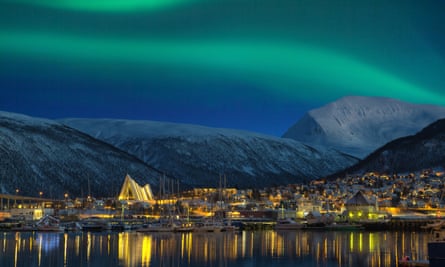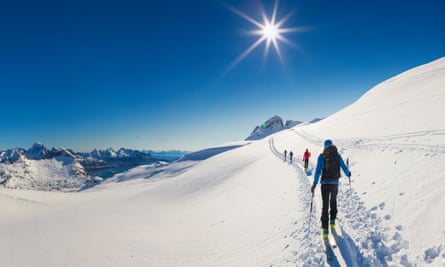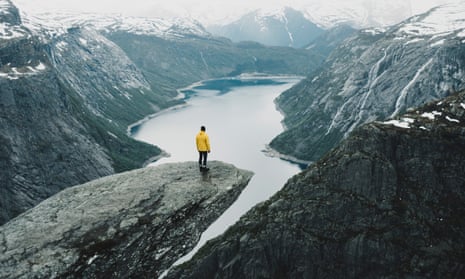When Kari Leibowitz first arrived in the Norwegian city of Tromsø, she was both intrigued by, and fearful of, the approaching winter. Two hundred miles north of the Arctic Circle, the city does not see the sun from mid-November to mid-January. It was a far cry from the state of New Jersey, where she had grown up, or Stanford, California, where she had been studying before travelling to Norway.
As a health psychologist, Leibowitz’s aim was to understand the ways that Tromsø’s citizens coped with the long “polar night”. In many countries, the short days of winter are thought to cause lethargy and low mood, resulting in “seasonal affective disorder” (SAD). This is sometimes assumed to have a purely biological basis – levels of mood-regulating neurotransmitters such as serotonin are generally lower in winter than in summer, and last week a study suggested that people with more neurotic personalities are particularly susceptible to low winter moods. SAD is often treated using standard antidepressant drugs, as well as psychotherapies.
During the darkest periods of the polar night, Tromsø only receives two to three hours of indirect sunlight, shining into the sky from below the horizon. Yet its inhabitants do not show the kind of wintertime depression you might expect of a city cast in darkness. One study by May Trude Johnsen at the University of Tromsø found that the citizens’ wellbeing barely changed across the year. Their sleep was a bit more disturbed without the daily rhythm of the rising and setting sun, but they reported no increase in mental distress during the winter.
So what’s their secret? Of the many potential explanations, Leibowitz’s work suggests that one vital component may be a particular “mindset” that arms the citizens against the stresses of the long polar night.

These lessons could not be more timely. We may not live in the far north, but many of us in Europe and the US find winter to be the cruellest of all seasons – and that’s without the shadow of a global pandemic. Last week the Observer reported that as we face the daunting prospect of a second lockdown in cold dark conditions Brits have been stocking up on patio heaters and fire pits but, consumerism aside, what might we learn from the Norwegians’ psychological resilience?
Leibowitz’s findings build on decades of previous research showing that the mental framing of stressful events can powerfully influence the ways we are affected by them. People who see stressful events as “challenges”, with an opportunity to learn and adapt, tend to cope much better than those who focus more on the threatening aspects – like the possibility of failure, embarrassment or illness. These differences in mindset not only influence people’s mood, but also their physiological responses, such as changes in blood pressure and heart rate, and how quickly they recover after the event. And the impact can be long-lasting, even during major transitions: one Israeli study found that immigrants’ stress appraisals can predict how well they adjust to their new country. They also seem to determine how well police officers in Australia cope with the stresses of their work.
Needless to say, our appraisal of whether an event feels like a threat, or an opportunity, will depend on our circumstances and our resources to handle the problems we encounter. But it is sometimes possible to change our appraisal of a situation consciously. In one memorable experiment, Alison Wood Brooks, an associate professor at Harvard Business School, asked participants to face their fears of public speaking. Brooks found that simply asking the participants to repeat the phrase “I am excited” helped to reduce their anxious feelings and led to a better overall performance, since it encouraged them to view the situation as a new challenge rather than a threat. Many psychotherapies, such as cognitive behavioural therapy and acceptance and commitment therapy, have also been found to increase our resilience by helping us to reframe stressful events in more constructive ways.
To test whether a difference in outlook could also explain the resilience of Tromsø’s residents, Leibowitz designed the “wintertime mindset scale”, which asked participants to rate how much they agreed or disagreed with statements such as
There are many things to enjoy about the winter
I love the cosiness of the winter months
Winter brings many wonderful seasonal changes
And
Winter is boring
Winter is a limiting time of year
There are many things to dislike about winter
Sure enough, she found that participants’ answers predicted their wellbeing over the coming months; the more they saw the winter as an exciting opportunity to enjoy a glacial climate, the better they fared, with high levels of life satisfaction and overall mental health.
Amazingly, Leibowitz found that these attitudes actually increase with latitude, in the regions where the winters will be even harsher. People in Svalbard (at 78 deg north) had a more positive mindset than the people in Tromsø (69 deg north), who took a more optimistic view than people in Oslo (60 deg north). In other words, the positive wintertime mindset is most common where it’s most needed.
These positive attitudes were apparent in Leibowitz’s casual conversations; indeed, she says that many of her friends struggled to understand why you would not enjoy winter. They embraced the possibility of skiing or hiking in the mountains, and savoured the chance to practice koselig – a Norwegian version of Denmark’s hygge – which might involve snuggling under blankets with a warm drink in the candlelight. Far from dwindling in the dark, Tromsø’s community flourished in the long polar night. “There is this interaction between the culture that you’re part of, and the mentality or mindset that grows out of it,” says Prof Joar Vittersø, Leibowitz’s collaborator at the Arctic University of Tromsø.
Surrounded by Norwegian positivity, Leibowitz soon found her own mindset shifting; she learned to love long walks with a headlamp to guide her path. And rather than yearning for sunlight, she came to appreciate the “soft, peaceful” appearance of the city in the darkness. “When it was snowing, I would always try to go out and enjoy the fresh snowfall.”
She suspects that many other people could follow suit, once they find out about this research. “Most people don’t realise that their beliefs about winter are subjective,” says Leibowitz, whose research is currently under peer review. “They feel like they’re just someone who hates the winter and there’s nothing they can do about it… But once you put it in people’s heads that mindsets exist, and that you have control over your mindset – I think that that’s tremendously powerful.”
Leibowitz conducted her initial studies long before the new coronavirus left Wuhan – and she is realistic about the challenges of trying to see the positive in the pandemic. “A change in mindset is not a cure-all for everything,” she emphasises. It can’t simply eliminate our anxieties about the job insecurity or the fear of losing a loved one, and we should not attempt to suppress those emotions.
Even so, she suspects that adopting the positive wintertime mindset could make a second lockdown a little less daunting for those who worry about keeping their mood buoyed in the bad weather. We might recognise, for instance, that it’s a time for baking comfort food or cosy evenings curled up under a blanket in front of a box set – practising a little bit of the Norwegian koselig. And if we normally exercise on a running machine, we might try to find value in a bracing jog in the elements. Since the risk of contagion is much lower outside, we might also adapt to the Scandinavian way of outdoor socialising (lockdown regulations permitting). Tromsø, for example, has an open-air cinema, so residents can enjoy atmospheric film screenings in the eerie Arctic darkness. As the Norwegians say: “There is no such thing as bad weather, only bad clothes.”
This time, we do at least have the advantage of knowing what did and didn’t work during the first lockdown, so we can be more realistic in our expectations of what we can and can’t achieve, focusing our efforts on the small actions that bring the most comfort, rather than aiming to write a bestselling novel, say.
A recent study by Prof Hannes Zacher, a psychologist at Leipzig University, shows that our personal framing of the pandemic has already had a small but significant effect on our responses during the crisis so far.

The survey, which was set up before the crisis, ran from December 2019 to May this year – and as you might expect, there was a significant drop in life satisfaction and positive mood after the pandemic hit Europe. But certain psychological characteristics and coping strategies seemed to protect some people from the worst effects. This included “active coping” – such as setting up a proper office at home, scheduling home-schooling times for the children, and making sure to eat well, sleep well, and exercise, Zacher says. As the previous research predicted, the most resilient participants also managed to recognise the potential opportunities in the crisis – such as “learning something from the experience, or trying to grow as a person as a result from the experience,” Zacher explains.
Like Leibowitz, Zacher emphasises that the aim is not to sugar-coat the situation or to deny the difficulties that we will face; we can’t hide from the shadow cast by the pandemic, any more than the citizens of Tromsø can pretend that the sun is still rising. By recognising our own capacity to control our responses to the lockdown and the changing seasons, however, we may all find some hidden reserves of strength and resilience to see us through the days ahead.










Comments (…)
Sign in or create your Guardian account to join the discussion